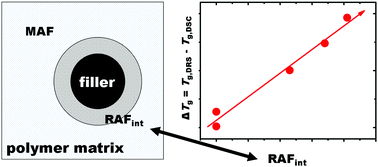Dynamic glass transition of the rigid amorphous fraction in polyurethane-urea/SiO2 nanocomposites†
Abstract
We report molecular dynamics in the rigid amorphous fraction (RAF) of the polymer bound at the interfaces with nanoparticles in polymer nanocomposites and calculate the glass transition temperature, Tg, for this bound layer of polymer. We follow the ‘3-phase-model’ for semicrystalline polymers where the polymer matrix consists of the crystalline fraction (CF), the mobile amorphous fraction (MAF) and the RAF. While the amorphous polymer bound by crystallites is completely rigid, neither contributing to the glass transition, nor displaying molecular dynamics, the amorphous polymer bound at the interfaces with filler displays decelerated dynamics, as compared to the bulk polymer. Reports in the literature suggest a discrepancy between Tg values obtained by Differential Scanning Calorimetry (DSC) and by Dielectric Relaxation Spectroscopy (DRS). As a plausible explanation we suggest that DRS results in Tg values taking into account the bound polymer, whereas DSC does not. For this investigation we use semicrystalline polyurethane-urea/SiO2 nanocomposites and employ, next to DSC and DRS, SEM, SAXS and WAXS for morphological characterization. It is our intention to use DRS as a tool for investigating the RAF.



 Please wait while we load your content...
Please wait while we load your content...